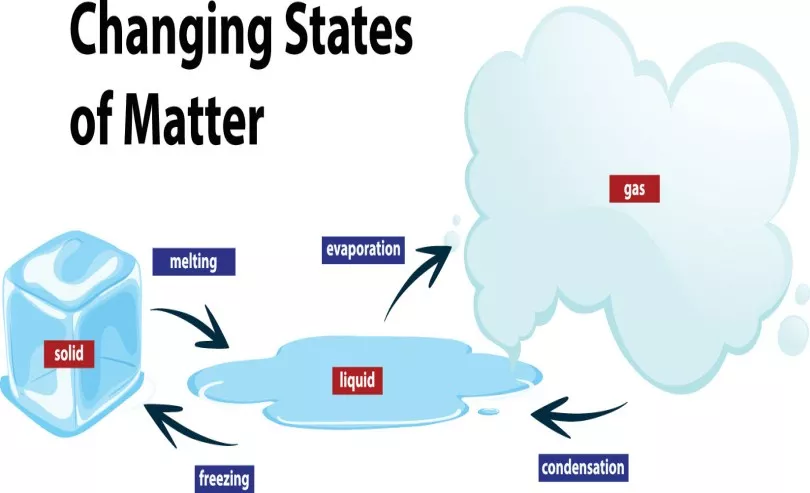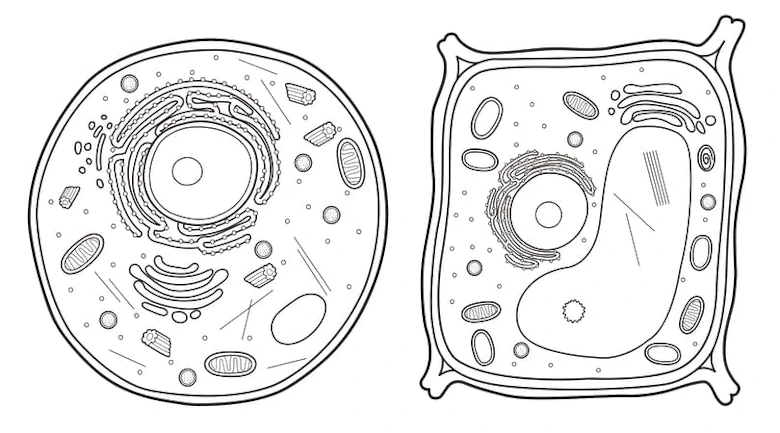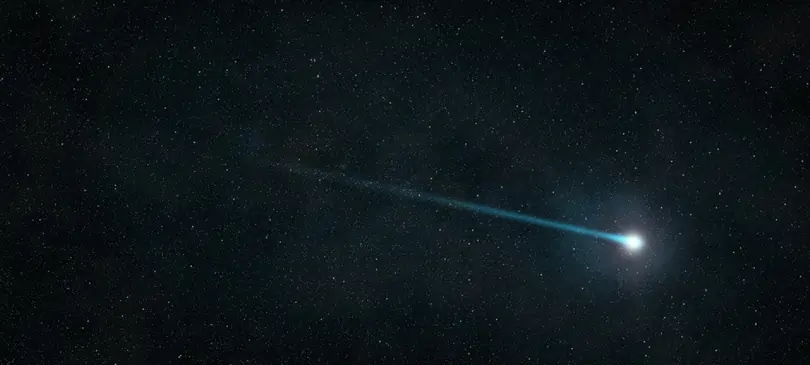Water Cycle
In this article, you will be introduced to the water cycle based on the Singapore Primary 5 Science Syllabus. We will focus on the following two main aspects:
- Processes in the water cycle
- Importance of the water cycle
Watch our video lesson!
What is the Water Cycle?
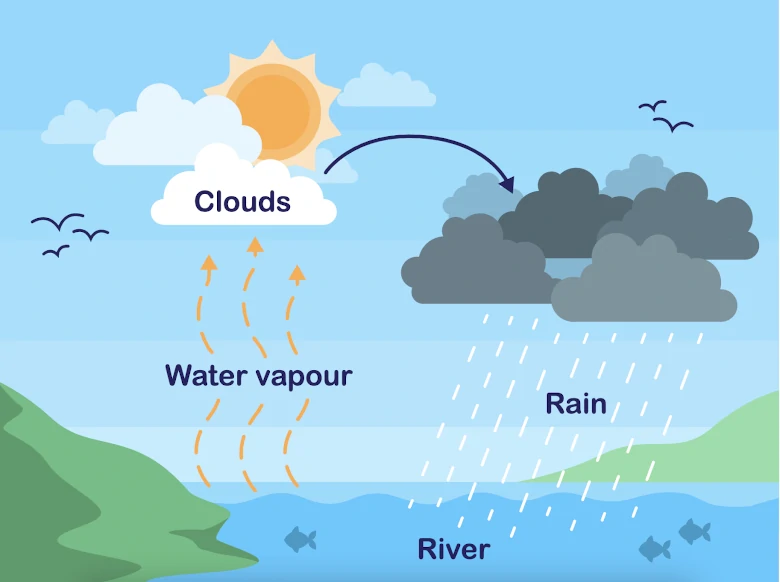
Water is important for the survival of living things on Earth. The water cycle shows the continuous movement of water from the Earth to the sky and back to the Earth. It involves water undergoing changes of state. The water cycle takes place due to the heat energy from the Sun.
- Evaporation from water bodies and the ground causes water vapour to be formed. Living things such as plants and animals release water vapour into the atmosphere as well.
- The water vapour will rise into the sky where the surrounding temperature is much lower. It will lose heat and condense to form water droplets which gather to form clouds.
- When the water droplets in the clouds get too heavy, they fall back to Earth as rain. This is also known as precipitation. Some of the water is returned directly to the water bodies while some seeps into the ground.
- The water cycle repeats itself.
Processes In The Water Cycle
Evaporation
The water in the water bodies such as rivers, lakes and seas will gain heat from the Sun and evaporate to form water vapour. Water from the ground will also evaporate.
Without heat from the Sun, evaporation cannot take place. As a result, water remains in the liquid state and will not become water vapour, hence the water cycle will not be able to occur.
Condensation
The warm water vapour in the atmosphere rises into the sky where the surrounding temperature is cooler. Warm water vapour will then lose heat to the cooler surroundings and condenses to form water droplets. These water droplets will then gather to form clouds, which will fall as rain once the water droplets get too heavy.
Without condensation, formation of clouds is no longer possible. Water vapour will remain in the gaseous state in the atmosphere and liquid water will not be able to return back to the Earth for the water cycle to continue.
Importance Of The Water Cycle
All living things need water to survive. The water cycle is essential for life as it provides living things with a continuous supply of freshwater. Even though 70% of our planet is covered with water, most of it is saltwater. Freshwater makes up a mere 3% of all the water on Earth, and two-thirds of it is unavailable for us to use (e.g. frozen glaciers).
When water evaporates from the saltwater in seas and oceans, impurities such as salt are left behind in the water bodies when water vapour is formed. This water vapour condenses into droplets of water which form clouds and return back to Earth as freshwater when it rains.
Water is required by humans to carry out various processes in our organ systems. For example, water is important to our digestive system as it is found in digestive juices. Water is also important to the circulatory system as it makes up 90% of our blood, which helps to transport substances such as oxygen and digested food around our bodies.
Water is also important to plants. For example, seeds need water to germinate. Water is also needed for the transport of substances in plants, and is needed for plants to carry out photosynthesis in the presence of sunlight.
Conclusion
In this article, we examined the various processes that take place in the water cycle. We have also learnt about the importance of the water cycle, and how water is essential for humans and plants.
Test Your Concepts
Answer the following questions based on the concepts that we have covered in this article. If you are unclear, you may want to revisit the relevant section to revise the concepts.
Question 1:
Which of the following statements are correct about the importance of the water cycle?
- The water cycle's main purpose is to clean the air.
- The water cycle increases the total amount of water on Earth.
- The water cycle ensures the constant supply of freshwater on Earth.
- The water cycle provides all the living things with freshwater for their survival.
Choose the correct option:
- A and B only
- C and D only
- B, C and D only
- A, B, C and D
Solution:
(2) C and D only
Explanation:
The water cycle ensures a continuous supply of freshwater that is needed for living things to survive.
Question 3:
Thomas built a terrarium by putting some wet soil, rocks and ferns in a glass bowl as shown in the diagram below. He sealed the top of the glass bowl with a cling wrap and placed the terrarium next to a window. The ferns in the terrarium survived for a long period of time even without Thomas watering them.
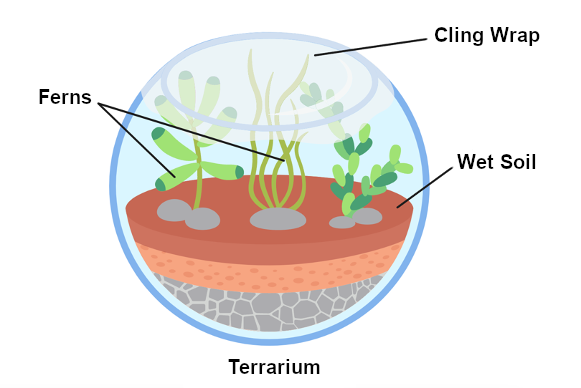
Which of the following processes take place in the terrarium?
- Water vapour is given out through the leaves of the ferns.
- Water in the soil loses heat and evaporates into water vapour.
- The water vapour loses heat to the cooler surface of the cling wrap and condenses into water droplets.
- Water droplets on the cling wrap will fall back onto the soil, which will then be absorbed by the ferns through their roots.
Choose the correct option:
- A and B only
- B and C only
- A, C and D only
- A, B, C and D
Solution:
(3) A, C and D only
Explanation:
Statements A, C and D are correct. Statement B is incorrect as water in the soil will gain heat and evaporate.
Test Yourself
A, B, C and D are processes occurring in the water cycle. In which of the processes would a change in state of water occur?

Process A involves evaporation in which water gains heat and changes from the liquid state to the gaseous state. At B, gaseous water vapour loses heat to the cooler surroundings and condenses to form tiny water droplets (liquid) which gather to form clouds.
A cup which contained very hot water was covered with a plastic cover as shown below.
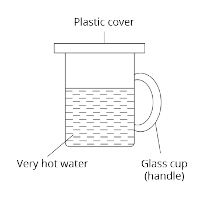
After 30 minutes, what changes Darren observed?

The hot water vapour from the hot water in the cup came into contact with the cooler underside of the plastic cover, lost heat and condensed into tiny water droplets.
Which one of the following statements is not true about evaporation and boiling?
1: Both processes occur in liquids.
2: Both processes require heat gain of liquids.
3: Both processes occur at a fixed temperature.
4: Both processes result in a change of state of matter.
Evaporation occurs all the time (at any temperature) while boiling occurs when the temperature of the liquid has reached its boiling point.




 SG
SG  VN
VN 

